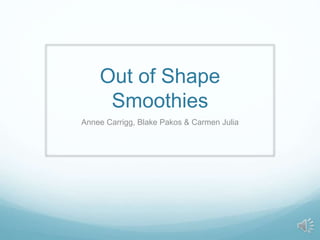
Out of Shape Smoothies Help Reduce Food Waste
- 1. Out of Shape Smoothies Annee Carrigg, Blake Pakos & Carmen Julia
- 2. The Problem $15 Billion dollars worth of fruits & vegetables thrown out per year 80% of freshwater used to produce fruits & vegetables US spends about $1 billion in disposal of food waste 40% of food in the US goes uneaten 23% of US methane emissions comes from landfill food
- 3. The Market Washington D.C. Men & women ages 18- 60 Health conscious Environmentally conscious
- 4. Smoothie Industry $6 billion dollars in sales of made-to-order & packaged smoothies Low-barriers to entry World market for smoothies is projected to reach $9 billion by 2015
- 5. Trends
- 6. Interviews How often do you purchase smoothies? How much are you willing to pay for a smoothie? Why do you choose a smoothie: a snack, meal replacement, dessert, or other? Does it matter if the smoothie uses organic or inorganic ingredients and healthy or unhealthy?
Notes de l'éditeur
- Grocery stores are throwing out ugly fruits and vegetables which is contributing to food waste and smoothies are expensive.
- Focus in Washington D.C., one of the healthiest cities in the United States, metropolitan, aim at men and women from the ages ranging from 18-60, who are in a time crunch while also health and environmentally conscious, middle class (disposable income) Prior year growth rate 2.3% Projected growth rate of about 10-13% Market Value = 2,943,650
- Prior year growth rate : 10% Projected growth rate : 50% The smoothie market in the U.S. generates more than $6 billion in sales each year, and smoothie consumption has nearly doubled in the last five years. In 2011, one-third of the American population purchased smoothies and the number of smoothie businesses is expected to triple during this decade
- Mainly the health and wellness movement
- Interviewed 5 people 213308 (# of users)*4.6(times per month)*3.00(product price) = 2,943,650 Average price willing to pay $5.10 Most people said it would be a snack or morning drink 4/5 said it mattered if it was healthy, want it to be